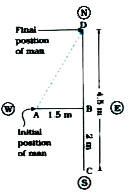A man travels a distance of 1.5 m towards East, then 2.0 m towards South and finally 4.5 m towards north.
(i) Calculate the total distance travelled.
(ii) Calculate the resultant displacement.Solution in Gujrati
The man starts from A and travels 1.5m towards east and reaches point B.
For B 2m towards south reaches point C.
From C4.5m towards north and teaches point D.
Total distance travelled
=AB+BC+CD
=(1.5+2+4.5)m=8m
The resultant displacement is AD. In right angled ΔABD,AB=1.5m.
BD=DC−BC=(4.5−2)=2.5m.
By Pythogoras. theorem,
AD2=AB2+BD2
=(1.5)2+(2.5)2=2.25+6.25=8.50
∴AD=√8.50≈2.92m
(i) Total distance travelled =8m.
(ii) The resultant displacement =2.92m.

Related Playlists
- BOOK - KUMAR PRAKASHANCHAPTER - MOTION EXERCISE - TEXTBOOK EXAMPLES/NUMERICALS14videos
MOTION
- BOOK - KUMAR PRAKASHANCHAPTER - MOTION EXERCISE - ADDITIONAL NUMERICALS FOR PRACTICE48videos
MOTION
- BOOK - KUMAR PRAKASHANCHAPTER - MOTION EXERCISE - MATCH THE FOLLOWING10videos
MOTION
- BOOK - KUMAR PRAKASHANCHAPTER - GRAVITATIONEXERCISE - ACTIVITY 10.42videos
GRAVITATION
- BOOK - KUMAR PRAKASHANCHAPTER - QUESTION PAPER 01EXERCISE - SECTION - D5videos
QUESTION PAPER 01
Similar Questions
An object travels 16 m in 4s and then another 16 m in 2 s. What is the average speed of the object?
02:37View SolutionA person completes 5 rounds (revolutions) on a circular path of radius 50 m. Find out the distance travelled by that person and magnitude (value) of displacement.
01:16View Solution 02:25View Solution
02:25View SolutionTake an empty plastic bottle . Close the mouth of the bottle with an airtight stopper . Put it in a bucket filled with watere . The bottle floats .
Push the bottle into the water. You feel an upward push. Try to push it further down. You will find it difficult to push deeper and deeper. Water exerts a force on the bottle in upward direction. Now release the bottle. It bounces back to the surface.
Does the force due to the gravitational attraction of the earth act on this bottle? If so, why doesn't the bottle stay immersed in water after it is released ?03:07View SolutionThe mass of a car is 1200 kg. It comes to rest due to retardation of 2ms−2 .
What would be the force (frictional force) acting between the car and road ?01:30View SolutionA particle moves 3 m north , then 4 m east and finally 6m south . Calculate the distance travelled and the displacement.
02:41View SolutionCalculate the distance travelled by the car, if a car travels 4km towards north at an angle of 45^(@) to the east and then travels a distance of 2km towards north at an angle of 135^(@) to the est.
View SolutionA man travels a distance of 1.5 m towards East, then 2.0 m towards South and finally 4.5 m towards East. (i) What is the total distance travelled ? (ii) What is his resultant displacement ?
03:50View SolutionA body travel a distance of 3 km towards East, then 4 km towards North and finally 9 km towards East. (i) What is the total distance travelled ? (ii) What is the resultant displacement ?
02:02View SolutionA man moves towards 3m north then 4 m towards east and finally 5 m towards 37∘ south of west. His displacement from origin is :-
03:52View SolutionA particle moved 5 m towards east then moved 8 m towards west. What is the total distance travelled and the magnitude of displacement?
02:24View SolutionA particle moves 3m north , then 4m east and finally 6m south . Calculate the distance travelled
02:23View SolutionA man walks 30 m towards north, then 20 m, towards east and in the last 30sqrt(2) m towards south - west. The displacement from origin is :
03:29View SolutionIf Hasmukh travels a distance of 4m towards East and then 3m towards North, what will be the total displacement of Hasmukh?
02:23View SolutionGanesh cycles towards South West a distance of 8 m, then he moves towards East a distance of 20 m. From there he moves towards North-East a distance of 8 m, then he moves towards West a distance of 6 m. From there he moves towards North-East a distance of 2 m. Then he moves towards West a distance of 4 m and then towards South-West 2 m and stops at that point. How far is he from the starting point?
02:55View Solution


